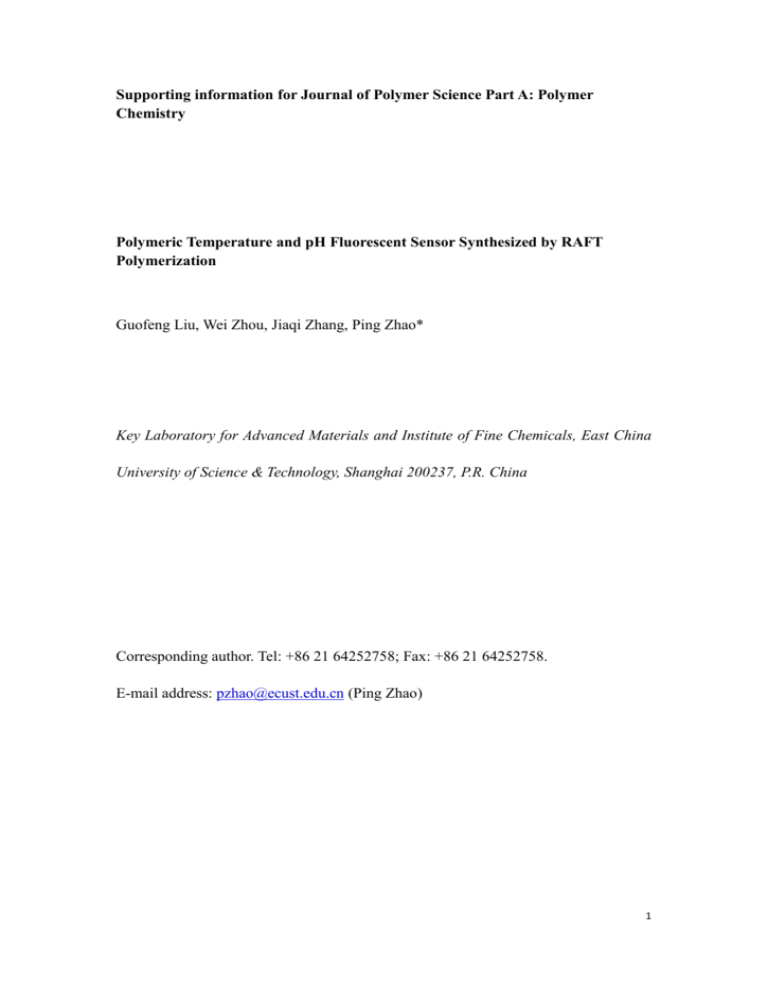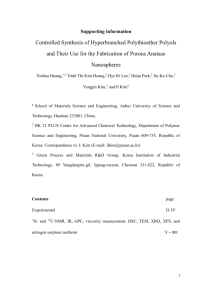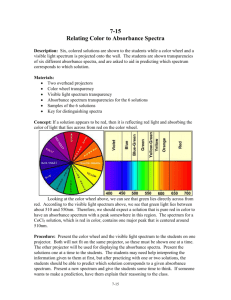POLA_25995_sm_SuppInfo
advertisement

Supporting information for Journal of Polymer Science Part A: Polymer Chemistry Polymeric Temperature and pH Fluorescent Sensor Synthesized by RAFT Polymerization Guofeng Liu, Wei Zhou, Jiaqi Zhang, Ping Zhao* Key Laboratory for Advanced Materials and Institute of Fine Chemicals, East China University of Science & Technology, Shanghai 200237, P.R. China Corresponding author. Tel: +86 21 64252758; Fax: +86 21 64252758. E-mail address: pzhao@ecust.edu.cn (Ping Zhao) 1 The molar ratio of NIPMAM and CPMA units incorporated in the copolymers. The molar ratio of m/n in poly(NIPMAMm-co-CPMAn) can be calculated according to the standard job’s plot of CPMA absorption spectra in methanol solution. From Figure S1, the standard job’s plot of CPMA (λabs = 380 nm) is fitted as Equation (1): YAbs = 0.01002 + 27084 × CCPMA (1) Mpoly(NIPMAM-co-CPMA) = MNIPMAM + MCPMA (2) Based on Figure S1(b), the absobance of 1.000 mg/mL poly(NIPMAMm-co-CPMAn) (PCN250) at 380nm is 0.8560, then for the resulting copolymer, the chromophore CCPMA is 3.124 × 10-5 M, MCPMA = 1.038×10-2 mg/mL. Therefore: M NIPMAM = M poly(NIPMAM-co-CPMA) – MCPMA = 0.9896 mg/mL (3) C NIPMAM = 7.781× 10-3 M (4) m / n = C NIPMAM / C CPMA =250 / 1 (5) Based on Figure S1(b), the absobance of 1.000 mg/mL poly(NIPMAMm-co-CPMAn) (PCN51) at 380nm is 0.3880, then for the resulting copolymer, the chromophore CCPMA is 1.462 × 10-5 M, MCPMA = 4.859×10-3 mg/mL. Therefore: M NIPMAM = M poly(NIPMAM-co-CPMA) – MCPMA = 0.0951 mg/mL (6) C NIPMAM = 7.477× 10-4 M (7) m / n = C NIPMAM / C CPMA = 51 / 1 (8) 2 Figure Captions Figure S1. (a) 1H NMR spectrum of CPMA in DMSO-d6 at 25 °C; (b) 13 C NMR spectrum of CPMA in DMSO-d6 at 25 °C (TMS as internal standard) Figure S2. HRMS of CPMA Figure S3. 1H NMR spectrum of poly(NIPMAMm-co-CPMAn) (m/n=250, PCN250) in DMSO-d6 at 25 °C Figure S4. (a) Absorption spectra of monomer CPMA (0.5, 1.0, 2.0, 5.0 and 10.0 µM) in methanol solution. (b) The linear fit of absorbance at λabs = 380 nm of monomer CPMA (0.5, 1.0, 2.0, 5.0 and 10.0 µM) in methanol solution. (c) Absorption spectra of PCN250 (1.0 mg/mL) and PCN51 (0.1 mg/mL) in methanol solution. Figure S5. Absorbance spectra of PCN250 (1.0 mg/mL) in methanol/water solution (1/5, v/v; pH 7) at various temperatures. Every spectrum was acquired after reaching equilibrium. Figure S6. Fluorescence spectra of PCN250 (1.0 mg/mL) in methanol/water solution (1/5, v/v; pH 7) at various temperatures; excitation wavelength: 380nm. Every spectrum was acquired after reaching equilibrium. Figure S7. Absorbance spectra of PCN51 (1.0 mg/mL) in methanol/water solution (1/5, v/v; pH 7) at various temperatures. Every spectrum was acquired after reaching equilibrium. Figure S8. Fluorescent spectra of PCN51 (1.0 mg/mL) in methanol/water solution (1/5, v/v; pH 7) at various temperatures; excitation wavelength: 380nm. Every spectrum was acquired after reaching equilibrium. 3







